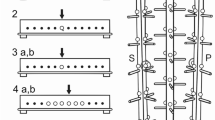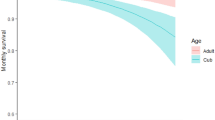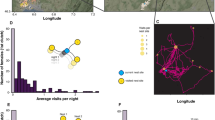Abstract
Most animals confine their activities to a discrete home range, long assumed to reflect the fitness benefits of obtaining spatial knowledge about the landscape. However, few empirical studies have linked spatial memory to home range development or determined how selection operates on spatial memory via the latter’s role in mediating space use. We assayed the cognitive ability of juvenile pheasants (Phasianus colchicus) reared under identical conditions before releasing them into the wild. Then, we used high-throughput tracking to record their movements as they developed their home ranges, and determined the location, timing and cause of mortality events. Individuals with greater spatial reference memory developed larger home ranges. Mortality risk from predators was highest at the periphery of an individual’s home range in areas where they had less experience and opportunity to obtain spatial information. Predation risk was lower in individuals with greater spatial memory and larger core home ranges, suggesting selection may operate on spatial memory by increasing the ability to learn about predation risk across the landscape. Our results reveal that spatial memory, determined from abstract cognitive assays, shapes home range development and variation, and suggests predation risk selects for spatial memory via experience-dependent spatial variation in mortality.
This is a preview of subscription content, access via your institution
Access options
Access Nature and 54 other Nature Portfolio journals
Get Nature+, our best-value online-access subscription
$29.99 / 30 days
cancel any time
Subscribe to this journal
Receive 12 digital issues and online access to articles
$119.00 per year
only $9.92 per issue
Buy this article
- Purchase on Springer Link
- Instant access to full article PDF
Prices may be subject to local taxes which are calculated during checkout


Similar content being viewed by others
Data availability
Data required to rerun the statistical analyses of this study are available online (https://data.mendeley.com/datasets/m89226xg6p)87. Animal AKDE models and GPS coordinates are available from the corresponding author upon request.
Code availability
R code used to run the simulation analyses of this study are available online (https://data.mendeley.com/datasets/m89226xg6p)87.
References
Börger, L., Dalziel, B. D. & Fryxell, J. M. Are there general mechanisms of animal home range behaviour? A review and prospects for future research. Ecol. Lett. 11, 637–650 (2008).
Burt, W. H. Territoriality and home range concepts as applied to mammals. J. Mammal. 24, 346 (1943).
Darwin, C. On the Origin of Species by Means of Natural Selection (D. Appleton Co., 1859).
Merkle, J., Fortin, D. & Morales, J. M. A memory‐based foraging tactic reveals an adaptive mechanism for restricted space use. Ecol. Lett. 17, 924–931 (2014).
Bordes, F., Morand, S., Kelt, D. A. & Van Vuren, D. H. Home range and parasite diversity in mammals. Am. Nat. 173, 467–474 (2009).
Morales, J. M. et al. Building the bridge between animal movement and population dynamics. Philos. Trans. R. Soc. B: Biol. Sci. 365, 2289–2301 (2010).
Lewis, M. A. & Murray, J. D. Modelling territoriality and wolf-deer interactions. Nature 366, 738–740 (1993).
Kelt, D. A. & Van Vuren, D. H. The ecology and macroecology of mammalian home range area. Am. Nat. 157, 637–645 (2001).
Wang, M. & Grimm, V. Home range dynamics and population regulation: an individual-based model of the common shrew Sorex araneus. Ecol. Modell. 205, 397–409 (2007).
Moorcroft, P. R., Lewis, M. A. & Crabtree, R. L. Mechanistic home range models capture spatial patterns and dynamics of coyote territories in Yellowstone. Proc. R. Soc. B: Biol. Sci. 273, 1651–1659 (2006).
Powell, R. A. in Research Techniques in Animal Ecology Vol. 65 (eds. Boitani, L. & Fuller, T. K.) 599 (Columbia Univ. Press, 2000).
Spencer, W. D. Home ranges and the value of spatial information. J. Mammal. 93, 929–947 (2012).
Bracis, C., Gurarie, E., Van Moorter, B. & Goodwin, R. A. Memory effects on movement behavior in animal foraging. PLoS ONE 10, e0136057 (2015).
Fagan, W. F. et al. Spatial memory and animal movement. Ecol. Lett. 16, 1316–1329 (2013).
Powell, R. A. & Mitchell, M. S. What is a home range? J. Mammal. 93, 948–958 (2012).
Stamps, J. Motor learning and the value of familiar space. Am. Nat. 146, 41–58 (1995).
Gautestad, A. O. & Mysterud, I. Spatial memory, habitat auto-facilitation and the emergence of fractal home range patterns. Ecol. Modell. 221, 2741–2750 (2010).
Gautestad, A. O. & Mysterud, I. Intrinsic scaling complexity in animal dispersion and abundance. Am. Nat. 165, 44–55 (2005).
Merkle, J. A., Potts, J. R. & Fortin, D. Energy benefits and emergent space use patterns of an empirically parameterized model of memory‐based patch selection. Oikos 126, 185–196 (2017).
Schlägel, U. E. & Lewis, M. A. Detecting effects of spatial memory and dynamic information on animal movement decisions. Methods Ecol. Evolution 5, 1236–1246 (2014).
Van Moorter, B. et al. Memory keeps you at home: a mechanistic model for home range emergence. Oikos 118, 641–652 (2009).
Riotte-Lambert, L., Benhamou, S. & Chamaillé-Jammes, S. How memory-based movement leads to nonterritorial spatial segregation. Am. Naturalist 185, E103–E116 (2015).
Marchand, P. et al. Combining familiarity and landscape features helps break down the barriers between movements and home ranges in a non‐territorial large herbivore. J. Anim. Ecol. 86, 371–383 (2017).
Gautestad, A. O., Loe, L. E. & Mysterud, A. Inferring spatial memory and spatiotemporal scaling from GPS data: comparing red deer Cervus elaphus movements with simulation models. J. Anim. Ecol. 82, 572–586 (2013).
Ranc, N., Cagnacci, F. & Moorcroft, P. R. Memory drives the formation of animal home ranges: evidence from a reintroduction. Ecol. Lett. 25, 716–728 (2022).
Ranc, N., Moorcroft, P. R., Ossi, F. & Cagnacci, F. Experimental evidence of memory-based foraging decisions in a large wild mammal. Proc. Natl Acad. Sci. USA 118, e2014856118 (2021).
Potts, J. R. & Lewis, M. A. A mathematical approach to territorial pattern formation. Am. Math. Monthly 121, 754–770 (2014).
Shettleworth, S. J. Cognition, Evolution, and Behavior (Oxford Univ. Press, 2009).
van Asselen, M. et al. Brain areas involved in spatial working memory. Neuropsychologia 44, 1185–1194 (2006).
Paul, C., Magda, G. & Abel, S. Spatial memory: theoretical basis and comparative review on experimental methods in rodents. Behav. Brain Res. 203, 151–164 (2009).
Boratyński, Z. Energetic constraints on mammalian home-range size. Funct. Ecol. 34, 468–474 (2020).
Tamburello, N., Côté, I. M. & Dulvy, N. K. Energy and the scaling of animal space use. Am. Naturalist 186, 196–211 (2015).
McNab, B. K. Bioenergetics and the determination of home range size. Am. Naturalist 97, 133–140 (1963).
McNab, B. K. Food habits, energetics, and the population biology of mammals. Am. Naturalist 116, 106–124 (1980).
Fokidis, H. B., Risch, T. S. & Glenn, T. C. Reproductive and resource benefits to large female body size in a mammal with female-biased sexual size dimorphism. Anim. Behav. 73, 479–488 (2007).
Saïd, S. et al. What shapes intra-specific variation in home range size? A case study of female roe deer. Oikos 118, 1299–1306 (2009).
Schradin, C. et al. Female home range size is regulated by resource distribution and intraspecific competition: a long-term field study. Anim. Behav. 79, 195–203 (2010).
Dröge, E., Creel, S., Becker, M. S. & M’soka, J. Risky times and risky places interact to affect prey behaviour. Nat. Ecol. Evolution 1, 1123–1128 (2017).
Croston, R., Branch, C., Kozlovsky, D., Dukas, R. & Pravosudov, V. Heritability and the evolution of cognitive traits. Behav. Ecol. 26, 1447–1459 (2015).
Ashton, B. J., Ridley, A. R., Edwards, E. K. & Thornton, A. Cognitive performance is linked to group size and affects fitness in Australian magpies. Nature 554, 364–367 (2018).
Madden, J. R., Langley, E. J. G., Whiteside, M. A., Beardsworth, C. E. & Van Horik, J. O. The quick are the dead: pheasants that are slow to reverse a learned association survive for longer in the wild. Philos. Trans. R. Soc. B. Biol. Sci. https://doi.org/10.1098/rstb.2017.0297 (2018).
Sonnenberg, B. R., Branch, C. L., Pitera, A. M., Bridge, E. & Pravosudov, V. V. Natural selection and spatial cognition in wild food-caching mountain chickadees. Curr. Biol. 29, 670–676 (2019).
Shaw, R. C., MacKinlay, R. D., Clayton, N. S. & Burns, K. C. Memory performance influences male reproductive success in a wild bird. Curr. Biol. 29, 1498–1502.e3 (2019).
Gehr, B. et al. Stay home, stay safe—site familiarity reduces predation risk in a large herbivore in two contrasting study sites. J. Anim. Ecol. 89, 1329–1339 (2020).
Palmer, M. S., Fieberg, J., Swanson, A., Kosmala, M. & Packer, C. A ‘dynamic’ landscape of fear: prey responses to spatiotemporal variations in predation risk across the lunar cycle. Ecol. Lett. 20, 1364–1373 (2017).
Willems, E. P. & Hill, R. A. Predator-specific landscapes of fear and resource distribution: effects on spatial range use. Ecology 90, 546–555 (2009).
Gaynor, K. M., Brown, J. S., Middleton, A. D., Power, M. E. & Brashares, J. S. Landscapes of fear: spatial patterns of risk perception and response. Trends Ecol. Evolution 34, 355–368 (2019).
Bose, S. et al. Implications of fidelity and philopatry for the population structure of female black-tailed deer. Behav. Ecol. 28, 983–990 (2017).
Forrester, T. D., Casady, D. S. & Wittmer, H. U. Home sweet home: fitness consequences of site familiarity in female black-tailed deer. Behav. Ecol. Sociobiol. 69, 603–612 (2015).
Magrath, R. D., Haff, T. M., Fallow, P. M. & Radford, A. N. Eavesdropping on heterospecific alarm calls: from mechanisms to consequences. Biol. Rev. 90, 560–586 (2015).
Skelhorn, J. & Rowe, C. Cognition and the evolution of camouflage. Proc. R. Soc. B: Biol. Sci. 283, 20152890 (2016).
Dickinson, A. Associative learning and animal cognition. Philos. Trans. R. Soc. B: Biol. Sci. 367, 2733–2742 (2012).
Baddeley, A. D. & Lieberman, K. in Exploring Working Memory 206–223 (Routledge, 2017).
Olton, D. S. & Samuelson, R. J. Remembrance of places passed: spatial memory in rats. J. Exp. Psychol. Anim. Behav. Process. 2, 97–116 (1976).
Lashley, K. S. Brain Mechanisms and Intelligence: A Quantitative Study of Injuries to the Brain (Univ. Chicago Press, 1929).
O’keefe, J. & Nadel, L. The Hippocampus as a Cognitive Map (Oxford Univ. Press, 1978).
Beardsworth, C. E. et al. Is habitat selection in the wild shaped by individual-level cognitive biases in orientation strategy? Ecol. Lett. 24, 751–760 (2021).
Rowe, C. & Healy, S. D. Measuring variation in cognition. Behav. Ecol. 25, 1287–1292 (2014).
Warner, R. E. Use of cover by pheasant broods in east-central Illinois. J. Wildl. Manag. 43, 334 (1979).
Toledo, S. et al. Cognitive map-based navigation in wild bats revealed by a new high-throughput tracking system. Science 369, 188–193 (2020).
Weiser, A. W. et al. Characterizing the accuracy of a self-synchronized reverse-GPS wildlife localization system. In Proc. 2016 15th ACM/IEEE International Conference on Information Processing in Sensor Networks, IPSN 2016 1–12 (IEEE, 2016).
Nathan, R. et al. Big-data approaches lead to an increased understanding of the ecology of animal movement. Science 375, eabg1780 (2022).
Beardsworth, C. E. et al. Validating ATLAS: a regional-scale high-throughput tracking system. Methods Ecol. Evolution 13, 1990–2004 (2022).
Calabrese, J. M., Fleming, C. H. & Gurarie, E. ctmm: an r package for analyzing animal relocation data as a continuous-time stochastic process. Methods Ecol. Evolution 7, 1124–1132 (2016).
Clutton‐Brock, T. H. & Harvey, P. H. Primates, brains and ecology. J. Zool. 190, 309–323 (1980).
Avgar, T. et al. Space-use behaviour of woodland caribou based on a cognitive movement model. J. Anim. Ecol. 84, 1059–1070 (2015).
Laundré, J. W., Hernández, L. & Ripple, W. J. The landscape of fear: ecological implications of being afraid. Open Ecol. J. 3, 1–7 (2010).
Stephens, D. W. & Krebs, J. R. Foraging Theory (Princeton Univ. Press, 2019).
Beauchamp, G. Animal Vigilance: Monitoring Predators and Competitors. Animal Vigilance: Monitoring Predators and Competitors (Elsevier, 2015).
Langley, E. J. G. et al. Heritability and correlations among learning and inhibitory control traits. Behav. Ecol. 31, 798–806 (2020).
Chen, J., Zou, Y., Sun, Y.-H. & Ten Cate, C. Problem-solving males become more attractive to female budgerigars. Science 363, 166–167 (2019).
Vale, R., Evans, D. A. & Branco, T. Rapid spatial learning controls instinctive defensive behavior in mice. Curr. Biol. 27, 1342–1349 (2017).
Burt de Perera, T. & Guilford, T. Rapid learning of shelter position in an intertidal fish, the shanny Lipophrys pholis L. J. Fish. Biol. 72, 1386–1392 (2008).
Font, E. Rapid learning of a spatial memory task in a lacertid lizard (Podarcis liolepis). Behav. Procs. 169, 103963 (2019).
Senar, J. & Pascual, J. Keel and tarsus length may provide a good predictor of avian body size. Ard.-Wageningen 85, 269–274 (1997).
Lavielle, M. Detection of multiple changes in a sequence of dependent variables. Stoch. Process. Appl. 83, 79–102 (1999).
Calenge, C. The package ‘adehabitat’ for the R software: a tool for the analysis of space and habitat use by animals. Ecol. Modell. 197, 516–519 (2006).
Millspaugh, J. J. A Manual for Wildlife Radio Tagging Robert E. Kenward. The Auk 118 (Academic Press, 2001).
Gupte, P. R. et al. A guide to pre-processing high-throughput animal tracking data. J. Anim. Ecol. 91, 287–307 (2022).
R Development Core Team. R: A Language and Environment for Statistical Computing (R Foundation for Statistical Computing, 2018).
Grahn, M., Göransson, G. & Von Schantz, T. Territory acquisition and mating success in pheasants, Phasianus colchicus: an experiment. Anim. Behav. 46, 721–730 (1993).
Ridley, M. W. & Hill, D. A. Social organization in the pheasant (Phasianus colchicus): harem formation, mate selection and the role of mate guarding. J. Zool. 211, 619–630 (1987).
Gompper, M. E. & Gittleman, J. L. Home range scaling: intraspecific and comparative trends. Oecologia 87, 343–348 (1991).
Fisher, R. A. in Breakthroughs in Statistics (eds Kotz, S. & Johnson, N. L.) 66–70 (Springer, 1992).
Barton, K. MuMIn: Multi-Model Inference (cran.r-project.org, 2022).
Nakagawa, S. A farewell to Bonferroni: the problems of low statistical power and publication bias. Behav. Ecol. 15, 1044–1045 (2004).
Heathcote, R. Data for ‘Spatial memory predicts home range size and predation risk in pheasants’ nature ecology and evolution. Mendeley Data https://doi.org/10.17632/m89226xg6p.1 (2022).
Acknowledgements
We thank Rothamsted Research North Wyke for accommodating the rearing and release of the pheasants, and various landowners in Devon for hosting our tracking equipment. We also thank the Minerva Foundation and the Minerva Center for movement ecology for their persistence in supporting and developing ATLAS. Additionally, we thank K. Griffin and A. Morris for their help with data collection and animal husbandry, and F. Moultrie for helpful discussions and comments on the manuscript. We also thank N. Griffiths of Sporting Shots Ltd for supplying the pheasants for the carcass tracking experiment. This work was funded by an European Research Council Consolidator award no. 616474 to J.R.M.
Author information
Authors and Affiliations
Contributions
R.J.P.H. and J.R.M. conceived the idea for the manuscript. C.E.B., P.R.L., M.A.W., J.O.v.H. and J.R.M. collected the cognition data. M.A.W., C.E.B. and J.R.M. collected the movement data. R.J.P.H. and M.A.W. carried out the carcass tracking study. R.J.P.H. conducted the analyses and led the writing. R.N., Y.O. and S.T. developed the reverse‐GPS system and provided support throughout data collection. All authors contributed critically to the drafts.
Corresponding author
Ethics declarations
Competing interests
The authors declare no competing interests.
Peer review
Peer review information
Nature Ecology & Evolution thanks Francesca Cagnacci and the other, anonymous, reviewer(s) for their contribution to the peer review of this work. Peer reviewer reports are available.
Additional information
Publisher’s note Springer Nature remains neutral with regard to jurisdictional claims in published maps and institutional affiliations.
Extended data
Extended Data Fig. 1 Home range overlaps with simulated and real high-risk regions.
Density plot showing the proportion of the surviving bird’s home range that overlaps with the high-risk region of the landscape. The vertical dashed blue line indicates the mean proportion of home range overlaps with the real high-risk region.
Extended Data Fig. 2
Histogram comparison of distribution of home range isopleths where deaths occur for the birds that were killed (right plot) compared to all non-predated neighbour who’s 100% minimum convex polygon overlapped with the death location (left plot).
Supplementary information
Rights and permissions
Springer Nature or its licensor (e.g. a society or other partner) holds exclusive rights to this article under a publishing agreement with the author(s) or other rightsholder(s); author self-archiving of the accepted manuscript version of this article is solely governed by the terms of such publishing agreement and applicable law.
About this article
Cite this article
Heathcote, R.J.P., Whiteside, M.A., Beardsworth, C.E. et al. Spatial memory predicts home range size and predation risk in pheasants. Nat Ecol Evol 7, 461–471 (2023). https://doi.org/10.1038/s41559-022-01950-5
Received:
Accepted:
Published:
Issue Date:
DOI: https://doi.org/10.1038/s41559-022-01950-5
This article is cited by
-
Prospecting during egg laying informs incubation recess movements of eastern wild turkeys
Movement Ecology (2024)
-
The role of memory-based movements in the formation of animal home ranges
Journal of Mathematical Biology (2024)
-
Memory pays off
Nature Ecology & Evolution (2023)
-
Heliconiini butterflies as a case study in evolutionary cognitive ecology: behavioural innovation and mushroom body expansion
Behavioral Ecology and Sociobiology (2023)



